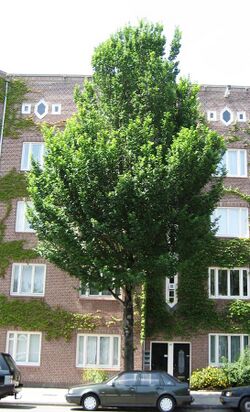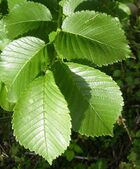Biology:Ulmus 'Clusius'
| Ulmus 'Clusius' | |
|---|---|
 Ulmus 'Clusius', Netherlands. | |
| Genus | Ulmus |
| Hybrid parentage | ('Exoniensis' × U. wallichiana) × 'Bea Schwarz' selfed |
| Cultivar | 'Clusius' |
| Origin | Wageningen, The Netherlands |
Ulmus 'Clusius' is a Dutch hybrid elm cultivar raised at the Dorschkamp Research Institute for Forestry & Landscape Planning, Wageningen, and released to commerce in 1983. 'Clusius' was derived from a crossing of the same Dutch clones that produced the fastigiate 'Lobel' released in 1973: '202' ('Exoniensis' × U. wallichiana) and '336' ('Bea Schwarz' selfed).
Description
The tree has a broader crown than its siblings', whilst the generally obovate leaves, < 11 cm long by 7 cm wide, are less acuminate at the apex.[1][2] Like 'Lobel', the tree flushes markedly later than most other elms, and is rarely in full leaf before mid-May.
Pests and diseases
Whilst the resistance of 'Clusius' to Dutch elm disease proved marginally greater than that of its Dutch predecessors, rated 4 out of 5,[3] it has been eclipsed by later developments such as Lutèce. Consequently, sales in the Netherlands declined from over 8,000 in 1979 to 600 in 2004.[4]
Cultivation
While 'Clusius' remains for sale in Europe, its planting where the disease remains prevalent cannot be recommended.[5] 'Clusius' featured in New Zealand government trials during the 1990s at the Hortresearch station, Palmerston North, but is not known to have been introduced to North America.
Etymology
The cultivar is named for Carolus Clusius, a Dutch naturalist of the Renaissance.
Accessions
- Europe
- Arboretum de La Petite Loiterie [1], Monthodon, France. No details available
- Grange Farm Arboretum, Sutton St James, Spalding, Lincs., UK. Acc. no. 817.
- Sir Harold Hillier Gardens, Ampfield, Romsey, Hampshire, UK. Acc. no: 2019.0441
- Wijdemeren City Council, Netherlands. Elm Collection. planted mainly in Kortenhoef since 2006.
Nurseries
- Noordplant [2], Glimmen, Netherlands.
References
- ↑ Heybroek, Hans M. (1983). Burdekin, D.A.. ed. "Resistant elms for Europe". Forestry Commission Bulletin (Research on Dutch Elm Disease in Europe) (London: HMSO) (60): 108–113. http://www.forestry.gov.uk/pdf/FCBU060.pdf/$FILE/FCBU060.pdf#page=118.
- ↑ Heybroek, H.M. (1993). "The Dutch Elm Breeding Program". in Sticklen, Mariam B.; Sherald, James L.. Dutch Elm Disease Research. New York, USA: Springer-Verlag. pp. 16–25. ISBN 978-1-4615-6874-2. https://books.google.com/books?id=avvxBwAAQBAJ&pg=PA16. Retrieved 26 October 2017.
- ↑ Heybroek, H. M., Goudzwaard, L, Kaljee, H. (2009). Iep of olm, karakterboom van de Lage Landen (:Elm, a tree with character of the Low Countries). KNNV, Uitgeverij. ISBN:978-90-5011-281-9
- ↑ Hiemstra, J.A. (2007). Belang en toekomst van de iep in Nederland. Wageningen, Netherlands: Praktijkonderzoek Plant & Omgeving B.V.. http://edepot.wur.nl/21797. Retrieved 26 October 2017.
- ↑ Burdekin, D.A.; Rushforth, K.D. (November 1996). Revised by J.F. Webber. "Elms resistant to Dutch elm disease". Arboriculture Research Note (Alice Holt Lodge, Farnham: Arboricultural Advisory & Information Service) 2/96: 1–9. ISSN 1362-5128. https://www.trees.org.uk/kenticotrees/Trees.org.uk/files/90/90f2d2f6-3d77-459c-8288-d951b0bf9782.pdf. Retrieved 26 October 2017.
 |


